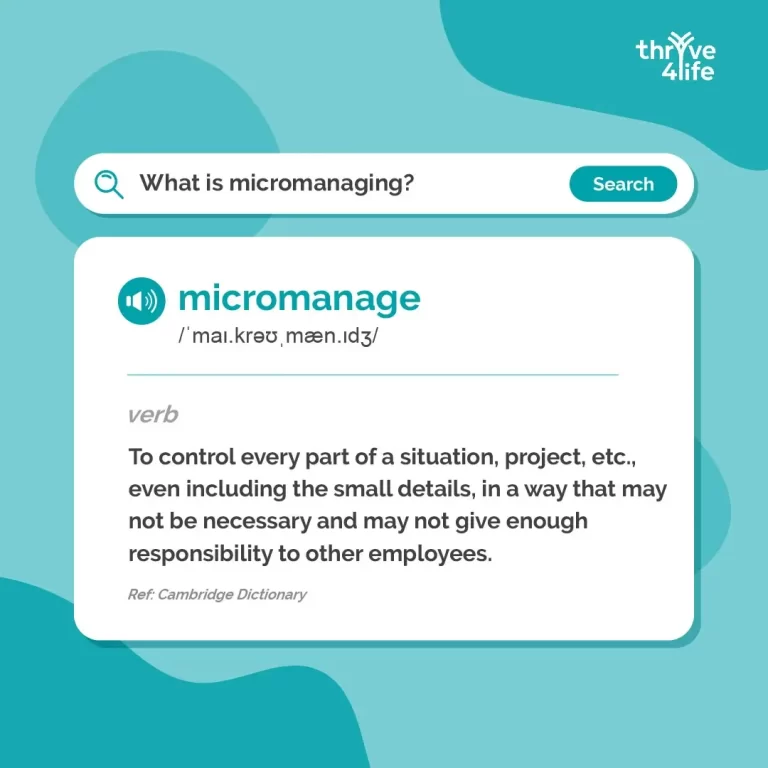The term ‘micromanagement’ has become somewhat of a business buzzword, used to describe management with excessive supervision or a controlling level of attention to detail. However, with ‘micromanagement’ trending online in recent years, what does it really mean in practice, and how can you detect the signs of it at work?
Micromanagement can often be confused with conscientiousness. An employer, for example, might give an employee highly detailed instructions to work with in an effort to thoroughly guide them through a task and achieve the end result they’re looking for. On the other hand, an employee might find themselves constantly being contacted for updates on a project, often outside their working hours, because their managers are so eager to learn how they’re getting on. Although both situations could merely be evidence of a supportive management style, this level of overseeing can quickly become immoderate and overbearing.
It may be time to address the micromanager in the room, and reclaim some of that employee morale most needed in our workplaces.

Remote and Hybrid Working Micromanagement
According to Forbes magazine, as of 2023, 12.7% of full-time employees work from home, while 28.2% work a hybrid model.¹ However, while the Covid-19 pandemic boosted working from home rates, it also gave rise to increased instances of micromanagement.
If one of your employees works from home, it’s only natural to want to know how they’re getting on, and it is normal to feel the need to check in. In fact, recent research indicates that 38% of managers perceived lower productivity among remote workers compared to those in the office, while 40% lacked confidence in their ability to manage remote employees effectively.² This explains why many managers may feel compelled to closely monitor their remote workers, sometimes to an excessive degree. Furthermore, with the increase in surveillance tools intended for management of remote employees, managers can establish whether an employee is online and actively working from afar. This can be great for establishing a team member’s availability for meetings, but such tools can also be used for employers to keep excessive tabs on remote employees’ work schedules.
If you’re frequently calling and messaging your employees in a manner that disrupts their work or disturbs their time outside of work, your management style might just be tipping over into the realms of micromanagement.
What Does Micromanagement Look Like in the Remote Workplace?
 Let me introduce you to Emily. She’s been working at your firm for 6 months and has recently switched to hybrid working. On one of her days in the office, you gave her a one-week deadline to complete the write up of a report on a new item being sold by your company. She thanks you for trusting her with such a responsibility and assures you it will be ready in time for the weekly reports meeting.
Let me introduce you to Emily. She’s been working at your firm for 6 months and has recently switched to hybrid working. On one of her days in the office, you gave her a one-week deadline to complete the write up of a report on a new item being sold by your company. She thanks you for trusting her with such a responsibility and assures you it will be ready in time for the weekly reports meeting.
The following day, you email her asking whether she has started. She responds, reassuring you she will begin when her prior work commitments are tied up. She estimates she will make a start at noon tomorrow and promises to have it completed by the deadline.
At noon the next day, you video call her to check she’s started. The day after, you email her asking for more updates. Half an hour passes and she hasn’t replied yet, so you text her personal number, even giving her a list of requirements you would follow if you were writing it. She replies saying she’s doing fine but it is obviously still in the middle of writing, but you insist she sends you the unfinished report for you to check over by the end of the next day. You are concerned over her ability to do it as well as you could, and ask her to send nightly updates for you so you can double-check. Emily obliges, but the constant checking up on her and the attempts to control every step of the process are making her feel more and more stressed and frustrated. The day before the report is due, you ask for her to send it over and end up rewriting sections of it that you feel you could do have done better. Emily is left feeling fed up and alienated from her role in the company. This situation is part of a wider pattern of behaviour that makes her question whether she wants to stay at the organisation.
The Impacts on Both Employee Wellbeing and Organisational Success
Micromanagement can significantly affect your employees’ wellbeing. Furthermore, it can also impact the overall morale and success of a company in general if this style of management becomes ingrained within its working culture.
HERE’S HOW A COMPANY AND ITS EMPLOYEES CAN SUFFER AS A RESULT OF MICROMANAGEMENT:
- The disruption micromanagement causes can significantly affect productivity levels.
- Having all aspects of a particular task controlled by one viewpoint can stifle a company’s growth and projections.
- Stress accounts for 45% of all working days lost due to ill health³, and not getting the chance to fully shine in their role, especially if tasks are rarely delegated or excessively overseen, can exacerbate employees’ stress levels and lead to burnout.
- Working relationships can sour if micromanagement is brought up, as it can be a sensitive subject between an employee and employer.
Signs You Are Being Micromanaged
- Monitoring: Your manager may frequently check in with you and constantly request updates regarding a task.
- Supervision: You might find that your manager insists on being involved with your work from start to finish, regardless of your experience in the role.
- Autonomy: You aren’t able to make decisions or lead in certain roles if your manager isn’t involved, and even then, they often take over.
- Instructions: Your manager’s help and guidance may spill into over-instructing and resemble more of a teacher/student relation than employer/employee.
- Productivity: When someone redoes your work or excessively controls it, it can be hard to feel motivated. This can lead to reduced productivity and a decreased level of care and attention to detail put into your work, often without even realising it.
We recommend reading this article by Jennifer Herrity for more signs of micromanaging.
Acknowledging The Problem
It might feel awkward, but discussing how you feel can help break the ice and encourage a positive conversation with your manager about how you’re feeling micromanaged. An employer probably won’t be aware that they’re micromanaging you and just want to be as helpful as possible as they oversee the minutiae of a task. Here’s how to clear it up:
- Request a private meeting with your manager to discuss how you feel.
- Be clear. Don’t try to sugar-coat your feelings – explain why you’re feeling stifled.
- Be understanding and try to provide examples of your manager’s style that you find micromanaging.
- Say what you want to happen next. If a manager doesn’t know they have micromanaging tendencies, they might not initially know how to improve or see why they should change how they work.
Signs You Might Be a Micromanager
- You are extremely thorough in providing instructions and specific information about a task, which may, in turn, stifle creative thought or input.
- You might be taking on too much work yourself, wanting to ensure deadlines are met.
- You constantly check in with your employees, wanting to monitor every detail of their progress.
- You struggle to trust your team with tasks, and you often take over from your employees before they have a chance to succeed.
- You’ve noticed a few employees seem less dedicated to their work. Perhaps some have recently resigned, or you’ve heard rumours that others are considering it.
- Your team is becoming less and less productive. They don’t see the point in putting their all into their work as they know you’ll change or completely redo the tasks they complete for you.
- You insist that someone’s “online” status on Teams is always turned on, struggling to trust that remote employees are working when they’re meant to be.
- You might not be flexible in your style of managing, instead relying on your team to fulfil tasks in a short space of time in order to meet your deadlines.
Studies show that millennials, a huge portion of the workforce, hold work-life balance in especially high regard, with 92% of people born between 1980 and 2000 valuing flexibility as a top priority when job hunting. If you don’t make deadline setting a mutual decision, you might inadvertently alienate some of your workforce.⁴
DID YOU KNOW…
A recent study by Accountemps suggests that 59% of workers have been managed by a micromanager at some point in their career, with 68% saying it had decreased their morale and 55% claiming it had negatively impacted their productivity levels.⁵
Finishing Thoughts
Whether you suspect you have a propensity to micromanage or you’ve noticed you’re being micromanaged, there are ways to combat this managerial style and re-establish a positive and engaging work environment for all.
Hearing that you have micromanaging tendencies can be difficult, especially if you didn’t realise that your managerial style was prone to crossing the threshold between helpful and excessive. However, by being open-minded and ready to engage in a non-judgemental, calm dialogue about your leadership style with your team, you can learn how to delegate and support your employees without being overbearing.
Cultivating a company culture built on trust, open communication, and effective delegation is paramount for both a company’s success and each employee’s wellbeing. Thrive4Life’s Line Manager Training course, focusing on Stress and Mental Health Management in the Workplace, offers an ideal starting point for honing your management approach to better support your team’s mental health and physical wellbeing. This is one way to learn how to manage, resolve, and prevent any micromanagement issues in the workplace.
Why is this so important? Because improving your management style should be a constant commitment, and establishing non-intrusive communication channels with your team not only cultivates trust and understanding but also boosts company morale—an objective we should all strive to achieve.
Micromanagement is something anyone can experience, but what matters is that we know how to address it and create happier, more supportive working environments that revolve around trust and communication.
Further Reading & References
Further Reading
References
“Micromanage”. Mirriam-Webster, www.merriam-webster.com/dictionary/micromanage
Fisher, Colin M. et.al. “How to Help (Without Micromanaging)” Harvard Business Review, www.hbr.org/2021/01/how-to-help-without-micromanaging
Brougham-Chandler, Aimee. “7 Signs You’re Dealing with a Micromanager (and How to Manage Them)”. BreathHR, www.breathehr.com/en-gb/blog/topic/health-and-wellbeing/8-signs-youre-dealing-with-a-micro-manager-and-how-to-manage-them
“Try These 12 Strategies If You Need to Stop Micromanaging”. Forbes Business, www.forbes.com/sites/forbescoachescouncil/2018/06/04/try-these-12-strategies-if-you-need-to-stop-micromanaging/?sh=20a032141c48
Reino, Vicky et.al. “Graduate Mental Wellbeing in the Workplace: A Report on Graduate Mental Wellbeing For Student Minds.” Student Minds, www.studentminds.org.uk/uploads/3/7/8/4/3784584/graduate_wellbeing_report_full_interactive.pdf “Burnout”.
Mental Health UK, www.mentalhealth-uk.org/burnout/
“Flexible Working: Key Facts for Employers”. Equality of Human Rights, www.equalityhumanrights.com/sites/default/files/flexible-working-key-facts-for-employers.pdf
“Micromanagement: What Is It? Why Do People Do It? How Can You Spot It?” Acuity Training, www.acuitytraining.co.uk/news-tips/micromanagement/#:~:text=Micromanagement%20Statistics,it%20had%20hurt%20their%20productivity.










